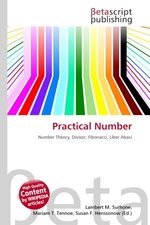Practical Number
Lambert M. Surhone, Miriam T. Timpledon, Susan F. Marseken
бумажная книга
High Quality Content by WIKIPEDIA articles! In number theory, a practical number or panarithmic number is a positive integer n such that all smaller positive integers can be represented as sums of distinct divisors of n. For example, 12 is a practical number because all the numbers from 1 to 11 can be expressed as sums of its divisors 1, 2, 3, 4, and 6: as well as these divisors themselves, we have 5=3+2, 7=6+1, 8=6+2, 9=6+3, 10=6+3+1, and 11=6+3+2. Practical numbers were used by Fibonacci in his Liber Abaci (1202) in connection with the problem of representing rational numbers as Egyptian fractions. Fibonacci does not formally define practical numbers, but he gives a table of Egyptian fraction expansions for fractions with practical denominators. The name "practical number" is due to Srinivasan (1948), who first attempted a classification of these numbers that was completed by Stewart (1954) and Sierpi?ski (1955).
Данное издание не является оригинальным. Книга печатается по технологии принт-он-деманд после получения заказа.


